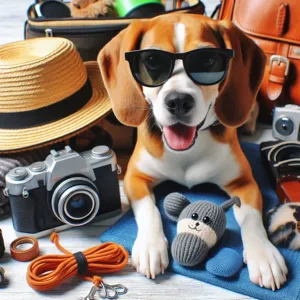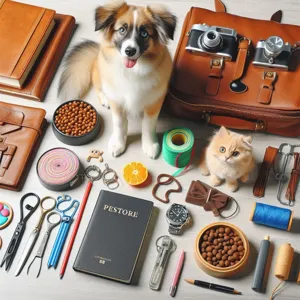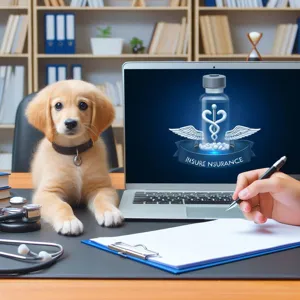Traveling with your furry companion can be a delightful adventure, but it often comes with its own set of challenges—especially when it comes to ensuring their comfort and safety during the journey.
Choosing the right pet carrier is crucial for making your travels as stress-free as possible, both for you and your beloved pet. With a multitude of options available, from sleek designs to cozy interiors, finding the perfect carrier can feel overwhelming. In this blog post, we’ll explore the top 10 pet carriers that combine practicality, style, and comfort, catering to the needs of every pet owner. Whether you’re planning a weekend getaway or a cross-country road trip, our carefully curated list will help you select a carrier that not only keeps your furry friend secure but also allows them to travel in style. Get ready to hit the road with peace of mind, knowing that your pet is snug and happy by your side!
1. Introduction: The Importance of Choosing the Right Pet Carrier

Traveling with your furry friend can be one of life’s most rewarding experiences, but it can also be a source of stress for both you and your pet. The key to a smooth journey lies in selecting the right pet carrier. This seemingly simple choice can significantly impact your pet’s comfort, safety, and overall travel experience. Imagine your dog or cat nestled snugly in a carrier that feels like their own little haven rather than a cramped cage—they’ll be more relaxed, making the trip enjoyable for everyone involved.
The right pet carrier not only provides your pet with a secure space but also brings peace of mind to you as a pet parent. It helps reduce anxiety during travel, whether you’re hopping in the car for a quick trip to the vet, embarking on a cross-country road trip, or catching a flight to a new destination. A well-ventilated, appropriately sized carrier allows your pet to move comfortably while still feeling secure, minimizing the likelihood of car sickness or panic.
Moreover, different types of carriers cater to various travel needs, from soft-sided carriers perfect for air travel to sturdy, hard-sided models ideal for car rides. Each option has its unique benefits, and understanding these can help you make an informed decision that suits your pet’s personality and your travel plans.
In this post, we’ll explore the top 10 pet carriers that prioritize comfort and convenience, ensuring that both you and your furry companion are ready for any adventure that lies ahead. So buckle up, and let’s delve into the world of pet carriers that keep tails wagging and whiskers twitching with joy!
2. Factors to Consider When Selecting a Pet Carrier
When choosing the perfect pet carrier, there are several crucial factors to consider that ensure both you and your furry friend enjoy stress-free travel. First and foremost, **size matters**. It’s essential to select a carrier that provides ample space for your pet to stand, turn around, and lie down comfortably. A cramped environment can lead to anxiety for your pet, making the journey less enjoyable.
Next, think about the **material and durability** of the carrier. Look for options made from high-quality, sturdy materials that can withstand wear and tear while also providing proper ventilation. Carriers with mesh panels are an excellent choice, as they allow your pet to see out and breathe easily, helping to reduce anxiety during travel.
**Weight** is another significant factor—especially if you plan to carry the carrier for long distances. Lightweight designs make transporting your pet more manageable, while still providing the sturdiness you need. Additionally, **ease of access** can’t be overlooked; carriers with top or side openings are often more convenient for loading and unloading your pet.
**Comfort features** are also essential. Consider carriers with padded bottoms or removable, washable liners to create a cozy environment for your pet. If you’re traveling by air, ensure that the carrier meets the specific airline regulations for dimensions and materials.
Lastly, **safety features** such as secure zippers and safety clips are vital to prevent any accidental escapes. A carrier that can be easily secured in your vehicle is also a plus, ensuring your pet’s safety throughout the journey. By keeping these factors in mind, you’ll be better equipped to choose a pet carrier that not only meets your travel needs but also keeps your furry friend comfortable and secure.
3. Safety Features to Look For

When it comes to traveling with your furry friend, ensuring their safety should be your top priority. A pet carrier isn’t just a convenient way to transport your pet; it serves as a secure haven that safeguards them during your journeys. Here are some crucial safety features to look for when selecting a carrier that will keep your pet comfortable and secure.
**Sturdy Construction:** Choose a carrier made from robust materials that can withstand the wear and tear of travel. Look for carriers with reinforced seams and a strong frame to prevent any accidental collapses or escapes.
**Secure Locking Mechanisms:** A reliable locking system is essential for preventing your pet from darting out unexpectedly. Opt for carriers with latches that are both easy for you to operate and difficult for your pet to manipulate. Double-locking mechanisms offer an extra layer of security.
**Ventilation:** Adequate airflow is crucial for your pet’s comfort and safety. Look for carriers that feature multiple ventilation openings, ensuring that air circulates freely. Well-ventilated carriers not only keep your pet cool but also help reduce anxiety during travel.
**Safety Straps and Seatbelt Attachments:** If you plan to travel by car, select a carrier that includes safety straps or seatbelt attachments. These features allow you to secure the carrier in place, preventing it from sliding or tipping over during sudden stops or sharp turns.
**Padded Interior:** A soft, padded interior not only enhances your pet’s comfort but also protects them from bumps and jolts during the journey. Look for carriers with removable, washable padding so that you can maintain a clean and cozy environment.
**Escape-Proof Design:** Make sure the carrier is designed in a way that minimizes the chances of your pet escaping. Features like mesh panels, reinforced zippers, and secure entry points help ensure that your furry friend stays safely inside, no matter the circumstances.
**Reflective Elements:** If you’re traveling in low-light conditions, carriers with reflective strips can enhance visibility, making it easier for you to spot your pet and ensuring that others can see you both. This feature is especially important during nighttime trips or in areas with heavy traffic.
By keeping these safety features in mind, you can choose a pet carrier that not only meets your travel needs but also provides peace of mind for both you and your furry companion. A safe and secure carrier is the first step toward a stress-free travel experience, allowing you and your pet to focus on making cherished memories together.
4. Comfort for Your Pet: Size and Design Considerations
When it comes to selecting the perfect pet carrier, comfort is key—not just for you, but for your furry friend as well. A well-designed carrier should accommodate your pet’s size and provide a cozy, reassuring environment that can alleviate travel stress.
First and foremost, consider the dimensions of the carrier. It should be spacious enough for your pet to stand up, turn around, and lie down comfortably. A cramped space can lead to anxiety, making your pet less willing to enter the carrier in the first place. Take the time to measure your pet from nose to tail and from the ground to the top of their head when standing. This will help ensure that you select a carrier that offers enough room for them to move freely.
Design elements also play a crucial role in your pet’s comfort. Look for carriers with breathable materials and adequate ventilation. Mesh panels are a great feature, as they allow for airflow and give your pet a view of their surroundings, which can be particularly calming. Additionally, padded interiors and soft bases can provide a cozy resting place, making the carrier feel more like a safe haven than a mere travel container.
Furthermore, consider the accessibility of the carrier. Features like wide openings, top or side entry, and secure zippers can make it easier to place your pet inside without causing them stress. Some carriers even come with removable and washable liners, ensuring that your pet’s travel space remains clean and comfortable.
Ultimately, choosing a carrier that prioritizes your pet’s comfort will not only enhance their travel experience but also strengthen the bond you share. When your furry friend feels secure and relaxed, you can both enjoy a stress-free journey together, whether it’s a quick trip to the vet or a cross-country adventure.
5. Top 10 Pet Carriers Overview

When it comes to traveling with your furry friend, the right pet carrier can make all the difference in ensuring a safe, comfortable, and stress-free journey. In this overview, we’ll explore the top 10 pet carriers that cater to a variety of needs, preferences, and travel styles, whether you’re heading out on a weekend road trip or a long-haul flight.
1. **Sherpa Original Deluxe Pet Carrier**: This airline-approved carrier boasts a stylish design with mesh panels for ventilation and a cozy interior that keeps your pet snug. Its adjustable strap and padded back make it convenient for carrying.
2. **Petmate Sky kennel**: A classic for road trips, this hard-sided carrier provides maximum durability and security. With ample ventilation and a sturdy construction, it’s perfect for larger pets that need more space.
3. **AmazonBasics Soft-Sided Pet Travel Carrier**: Offering great value, this lightweight soft-sided carrier features plenty of mesh panels for airflow and a removable, washable fleece pad for comfort, making it a great choice for short trips.
4. **Sleepypod Mobile Pet Bed**: Designed with both travel and comfort in mind, this carrier doubles as a pet bed when you reach your destination. Its crash-tested design ensures safety for your pet while on the move.
5. **KONG Pet Carrier**: Featuring an innovative design that prioritizes your pet’s comfort, the KONG carrier includes a soft padded interior and a unique structure that allows for easy access, perfect for anxious pets.
6. **PetFusion Ultimate Pet Carrier**: With its sturdy construction and spacious interior, this carrier is perfect for larger pets or multiple small pets. It also includes extra pockets for storing essentials, making it a practical choice for travel.
7. **Bergan Comfort Carrier**: This versatile carrier is ideal for both travel and everyday use. Its collapsible design allows for easy storage, while the padded shoulder strap ensures comfort during transport.
8. **ROVER Pet Carrier Backpack**: For adventurous pet parents, this backpack-style carrier is perfect for hiking or biking with your furry friend. It features a breathable mesh design and ample space for your pet to move around comfortably.
9. **PetSafe Happy Ride Dog Car Seat**: Specifically designed for car travel, this carrier keeps your pet secure while allowing them to enjoy the view. Its safety belt attachment and soft padding make it a great option for road trips.
10. **Loungefly Disney Pet Carrier**: For pet parents who love a fun twist, this stylish Disney-themed carrier is perfect for trips to the park or a day out. With its eye-catching design and comfort features, it’s sure to turn heads.
Each of these carriers has its unique advantages, and understanding your pet’s needs and your travel style will help you choose the best one for your adventures together. Whether your pet prefers the cozy confines of a soft-sided carrier or the sturdiness of a hard shell, there’s a perfect option out there for every pet parent.
6. Carrier #1: [Brand/Model Name] – Features and Benefits
### 6. Carrier #1: PetMate Sky Kennel – Features and Benefits
When it comes to traveling with your furry friend, the PetMate Sky Kennel stands out as an exceptional choice for pet owners seeking reliability and comfort. Designed with both safety and convenience in mind, this carrier is airline-approved, making it an excellent option for those planning to take to the skies.
One of the standout features of the PetMate Sky Kennel is its sturdy construction. Made from heavy-duty plastic and equipped with robust metal ventilation grilles, this carrier provides ample airflow while ensuring your pet remains secure during transit. The secure door latch keeps your pet safely enclosed, giving you peace of mind whether you’re on a long road trip or navigating airport security.
The interior of the kennel is designed for comfort, featuring a spacious layout that allows your pet to stand, turn around, and lie down comfortably. Its generous dimensions make it suitable for larger breeds, but it also accommodates smaller pets with ease. Additionally, the Sky Kennel comes with tie-down strap holes, allowing you to secure it in your vehicle to prevent any unexpected movement during travel.
Another significant advantage is the included pet identification stickers, which ensure that your furry friend is easily identifiable in case of a separation during travel. The carrier’s easy-to-clean surface is a bonus for pet owners, as it allows for quick maintenance after a long journey.
Overall, the PetMate Sky Kennel combines safety, comfort, and convenience, making it a top contender on our list of pet carriers. Whether you’re heading out for a weekend getaway or embarking on a cross-country adventure, this carrier is sure to keep your pet secure and content, allowing you both to enjoy a stress-free travel experience.
7. Carrier #2: [Brand/Model Name] – Features and Benefits

### 7. Carrier #2: PetMate Sky kennel – Features and Benefits
When it comes to finding the ideal carrier for your pet, the PetMate Sky Kennel stands out as a top contender for stress-free travel. Designed with both safety and comfort in mind, this carrier blends functionality with a user-friendly design, making it a favorite among pet owners.
**Features:**
1. **Sturdy Construction:** The PetMate Sky Kennel is crafted from durable plastic that can withstand the rigors of travel, ensuring your pet is secure during transit. Its robust design meets most airline regulations, providing peace of mind for air travel.
2. **Ventilation:** Featuring multiple vents on all sides, this carrier ensures ample airflow, which keeps your furry friend cool and comfortable. The strategic placement of these vents helps alleviate anxiety, allowing your pet to relax during the journey.
3. **Easy Access:** The double-latch door design is not just secure; it also allows for easy entry and exit. This feature is particularly beneficial when you need to quickly get your pet in and out of the carrier, whether at the airport or a rest stop.
4. **Built-in I.D. Holder:** The PetMate Sky Kennel includes a convenient I.D. holder, allowing you to easily attach identification and contact information. This feature is essential for ensuring your pet can be returned to you if they get lost during your travels.
5. **Size Options:** Available in various sizes, the PetMate Sky Kennel caters to pets of all breeds, from small cats to larger dogs. This variety ensures a snug fit, which is important for your pet’s comfort and security.
**Benefits:**
– **Stress Reduction:** Thanks to its thoughtful design, the PetMate Sky Kennel helps reduce stress for both you and your pet. With a comfortable and secure environment, your furry friend is less likely to feel anxious during travel.
– **Versatility:** Whether you’re taking a road trip, heading to the vet, or boarding a flight, this carrier is versatile enough to meet all your travel needs. Plus, it’s easy to clean, making post-travel maintenance a breeze.
– **Peace of Mind:** Knowing your pet is safely secured in a reliable and sturdy carrier allows you to focus on enjoying your travels. The PetMate Sky Kennel gives you that assurance, so you can create stress-free memories with your furry companion.
In summary, the PetMate Sky Kennel is more than just a pet carrier; it’s a travel companion designed to make your journeys smoother and more enjoyable. With its strong features and several benefits, it’s an excellent choice for pet owners looking to travel with their four-legged friends.
8. Carrier #3: [Brand/Model Name] – Features and Benefits
### Carrier #3: PetMate Sky Kennel – Features and Benefits
The PetMate Sky Kennel stands out as a top choice for pet owners seeking a durable and spacious travel solution for their furry companions. Designed with the needs of both pets and their owners in mind, this carrier brings a blend of comfort and safety that ensures a stress-free travel experience.
One of the standout features of the PetMate Sky Kennel is its robust construction, crafted from heavy-duty plastic that can withstand the rigors of travel while providing a secure environment for your pet. The carrier meets airline regulations, making it an ideal option for those planning to fly. With multiple ventilation holes on all four sides, it allows for ample airflow, keeping your pet comfortable throughout the journey.
Inside, the kennel is spacious enough for pets of various sizes, allowing them to sit, stand, lie down, and turn around with ease. This is particularly beneficial for nervous pets, as a little extra room can help reduce anxiety. Additionally, the PetMate Sky Kennel comes equipped with a convenient water bowl that attaches securely to the door, enabling hydration without the mess of spilled water.
For pet owners who prioritize ease of use, this carrier features a simple assembly process with no tools required. It also includes a secure locking mechanism that ensures your pet won’t escape during transit. The kennel’s handle is sturdy, providing a comfortable grip for easy carrying or lifting.
When it comes to travel safety, the PetMate Sky Kennel has you covered with its sturdy design and safety features. The door is reinforced to prevent accidental openings, and the carrier is compatible with standard safety straps, allowing you to secure it in your vehicle for road trips.
In summary, the PetMate Sky Kennel combines durability, comfort, and practicality, making it a top choice for pet owners seeking a reliable carrier for stress-free travel. Whether you’re embarking on a road trip or flying to a new destination, this carrier ensures that your furry friend travels in style and safety.
9. Carrier #4: [Brand/Model Name] – Features and Benefits
### 9. Carrier #4: PetMate Sky Kennel – Features and Benefits
When it comes to traveling with your furry companion, the PetMate Sky Kennel stands out as a top choice for pet owners seeking comfort, security, and convenience. Designed with both the pet’s and owner’s needs in mind, this carrier is perfect for both air travel and road trips.
**Features:**
The PetMate Sky Kennel boasts a robust construction made from high-quality plastic, ensuring durability and safety during transit. Its ventilated design features multiple air holes on all sides, providing ample airflow to keep your pet comfortable and relaxed, even during long journeys. The carrier is available in various sizes, accommodating pets weighing anywhere from 10 to 70 pounds, making it a versatile option for families with multiple pets.
One of its standout features is the easy-to-assemble design. The carrier comes with secure wing-nuts and bolts, making it simple to put together and take apart for storage. Traveling with your pet is made even easier with the integrated handle, which offers a comfortable grip, allowing you to maneuver through airports or parking lots with ease.
**Benefits:**
The PetMate Sky Kennel not only meets but exceeds airline regulations for pet travel, giving you peace of mind when flying with your furry friend. Its sturdy, escape-proof design ensures that your pet stays safe and secure, eliminating any worries about unexpected escapes during travel. Additionally, the kennel includes a travel guide that provides essential tips for traveling with pets, making it a comprehensive choice for new and seasoned pet travelers alike.
Another significant benefit of this carrier is its ease of cleaning. The plastic material can be easily wiped down, while the removable bottom tray allows for hassle-free cleanups after any accidents. Whether you’re heading on a weekend getaway or an extended vacation, the PetMate Sky Kennel offers a practical solution that prioritizes your pet’s comfort and your convenience.
With its thoughtful design and a host of benefits, the PetMate Sky Kennel is an excellent investment for pet owners looking to make travel as stress-free as possible for themselves and their beloved companions.
10. Carrier #5: [Brand/Model Name] – Features and Benefits
### 10. Carrier #5: PetMate Sky Blue Comfort Carrier – Features and Benefits
When it comes to travel, comfort is key, and the PetMate Sky Blue Comfort Carrier delivers just that for both you and your furry companion. Designed with the modern pet owner in mind, this carrier seamlessly blends style, functionality, and safety.
**Features:**
– **Spacious Design:** The PetMate Sky Blue Comfort Carrier provides ample room for your pet to move around comfortably during your journey. It’s perfect for small to medium-sized pets, accommodating them without feeling cramped.
– **Breathable Mesh Panels:** With strategically placed mesh windows, this carrier ensures optimal airflow, keeping your pet cool and calm as you travel. These panels also offer your furry friend a chance to peek outside, easing their anxiety by allowing them to see their surroundings.
– **Durable Construction:** Made from high-quality, lightweight materials, this carrier boasts a robust design that is both easy to carry and built to last. It features reinforced stitching and a sturdy base, ensuring your pet’s safety even on bumpy rides.
– **Secure Locking Mechanism:** Safety is a top priority, and the PetMate Comfort Carrier comes equipped with a secure locking door that keeps your pet safely inside while preventing any accidental escapes. The easy-open latch allows for quick access, making loading and unloading hassle-free.
– **Comfortable Padding:** The interior is lined with soft, removable padding, providing a cozy space for your pet to rest during travel. The padding is machine washable, allowing for easy cleaning and maintenance after your adventures.
**Benefits:**
Traveling with your pet doesn’t have to be stressful, and the PetMate Sky Blue Comfort Carrier helps create a more enjoyable experience for both of you. Its lightweight design makes it easy to carry through airports, car rides, or even just to your vet’s office.
Moreover, the stylish sky-blue color adds a touch of flair, ensuring that you and your pet travel in style. Whether you’re heading off on a weekend getaway or a longer road trip, this carrier is designed to keep your furry friend comfortable, secure, and happy throughout your journey. With the PetMate Sky Blue Comfort Carrier, you can embark on your travels with peace of mind, knowing that your beloved pet is traveling in comfort and safety.
11. Carrier #6: [Brand/Model Name] – Features and Benefits
### Carrier #6: PetMate Sky Kennel – Features and Benefits
When it comes to stress-free travel, the PetMate Sky Kennel stands out as a top choice for pet owners who prioritize safety and comfort. This airline-approved carrier is designed with both functionality and your pet’s well-being in mind, making it an exceptional option for any adventure, whether you’re flying across the country or embarking on a weekend road trip.
One of the standout features of the PetMate Sky Kennel is its robust construction. Made from durable, heavy-duty plastic, this carrier provides a secure environment, ensuring your furry friend stays safe during transit. The ventilation openings on all four sides promote airflow and visibility, allowing your pet to take in their surroundings while remaining calm and comfortable.
In terms of convenience, the PetMate Sky Kennel is equipped with an easy-to-use latch system that ensures the door remains securely closed. This feature is especially beneficial for pets that may feel anxious during travel, as it minimizes the risk of escape. Additionally, the carrier comes with a sturdy handle and is available in various sizes to accommodate pets of all breeds, from small terriers to large golden retrievers.
Another great benefit of this carrier is its inclusion of a “Live Animal” sticker and a travel guide, which can be immensely helpful for first-time travelers. This not only informs airline staff of your pet’s presence but also provides tips for a smoother journey.
Moreover, the PetMate Sky Kennel is designed with your pet’s comfort in mind. Inside, you can easily add a soft blanket or pet bed to create a cozy space, helping to reduce anxiety during travel. The carrier’s spacious design allows your pet to stand, turn around, and lie down comfortably, making it an ideal choice for longer trips.
In summary, the PetMate Sky Kennel combines safety, comfort, and practicality, making it a reliable companion for pet travel. Whether you’re heading to the vet or taking a cross-country flight, this carrier will help ensure your furry friend travels in style and comfort, giving you peace of mind every step of the way.
12. Carrier #7: [Brand/Model Name] – Features and Benefits
### Carrier #7: Petmate Sky Kennel – Features and Benefits
When it comes to traveling with your furry friend, the Petmate Sky Kennel stands out as a reliable and spacious option that prioritizes both comfort and safety. Designed with the needs of pets and their owners in mind, this carrier has garnered rave reviews from seasoned travelers.
One of the standout features of the Petmate Sky Kennel is its robust construction. Made from heavy-duty plastic, this carrier offers excellent durability while ensuring that your pet remains safe and secure during transit. The wire ventilation windows on all four sides allow for optimal airflow, keeping your pet comfortable and calm, no matter how long the journey.
Another significant benefit is the ample space provided within the kennel. Available in various sizes, the Petmate Sky Kennel accommodates pets of all breeds, from tiny terriers to larger dogs. With enough room to stand up, turn around, and lie down, your pet will feel less confined, which can significantly reduce travel anxiety.
Moreover, the kennel is designed with pet-friendly features such as tie-down strap holes that allow you to secure it in your vehicle safely, preventing any unwanted movement during travel. The easy-to-assemble design is another plus, as it requires no tools—just a simple twist of a few screws gets you ready to go.
For pet owners who prioritize travel convenience, the Petmate Sky Kennel also includes a “live animal” sticker that helps ensure your pet is treated with care during airline travel. With its comprehensive features and thoughtful construction, this carrier is an excellent choice for stress-free travel with your furry companion. Whether you’re embarking on a road trip or flying across the country, your pet will appreciate the comfort of the Petmate Sky Kennel, making both of your journeys enjoyable.
13. Carrier #8: [Brand/Model Name] – Features and Benefits
### Carrier #8: PetMate Sky Kennel – Features and Benefits
When it comes to traveling with your furry friend, the PetMate Sky Kennel stands out as a reliable and sturdy choice for pet owners seeking both safety and comfort. Designed with the needs of both pets and their humans in mind, this carrier effortlessly combines functionality with thoughtful features.
One of the standout attributes of the PetMate Sky Kennel is its robust construction. Made from heavy-duty plastic, it provides a secure environment for your pet during travel, whether you’re taking a short road trip or flying across the country. The metal door and ventilation holes ensure ample airflow, allowing your pet to breathe easily while still keeping them secure. You’ll appreciate the peace of mind knowing your pet is safe inside.
The kennel is available in various sizes, accommodating pets of different breeds and weights. This versatility makes it an excellent option for both small dogs and larger breeds, ensuring that your furry friend has enough room to sit, stand, and turn around comfortably. Additionally, the carrier meets most airline regulations, making it a perfect choice for those jet-setting with their companions.
Another significant benefit is the ease of assembly and transportation. The PetMate Sky Kennel features a simple design that allows for quick setup and takedown. It includes durable carry handles, which make it easy to lift and maneuver, whether you’re loading it into your vehicle or navigating through the airport. Plus, the kennel is designed for easy cleaning, with a removable floor and smooth surfaces that can be wiped down after each adventure.
For pet owners who prioritize visibility and comfort, the kennel also comes with a customizable name tag, allowing you to add your pet’s name and your contact information. This small touch can provide reassurance should you ever find yourself in a situation where your pet gets lost during travel.
In summary, the PetMate Sky Kennel is a feature-rich carrier that not only ensures the safety of your pet but also prioritizes their comfort. With its durable construction, ample ventilation, and thoughtful design elements, it’s an ideal choice for pet owners looking for a stress-free travel solution. Whether heading to the vet or embarking on an adventure, this carrier is sure to make the journey enjoyable for both you and your furry friend.
14. Carrier #9: [Brand/Model Name] – Features and Benefits
### Carrier #9: Pet Gear Ultimate Traveler – Features and Benefits
When it comes to traveling in style and comfort, the Pet Gear Ultimate Traveler is a standout choice for pet owners who prioritize both convenience and safety. Designed with the discerning pet traveler in mind, this carrier boasts a range of features that make it a top contender for stress-free journeys with your furry companion.
**Ample Space and Comfort:** The Ultimate Traveler offers generous dimensions, allowing your pet to sit, lie down, and turn around comfortably. Its plush, removable interior pad ensures a cozy resting place, which is especially important for longer trips.
**Superior Ventilation:** This carrier is equipped with multiple mesh panels, providing excellent airflow. Your pet will benefit from fresh air and visibility, alleviating feelings of confinement and anxiety during travel.
**Safety First:** Pet Gear has prioritized safety with a secure locking system, ensuring that your pet remains safely inside the carrier. The reinforced corners add extra durability, making this carrier a reliable choice for both car rides and air travel.
**Convenient Features:** With a collapsible design, the Ultimate Traveler is easy to store when not in use. It also includes a convenient side pocket for storing treats, leashes, or travel documents, keeping all essentials at your fingertips.
**Versatile Use:** Whether you’re embarking on a road trip, heading to the vet, or flying across the country, this carrier is airline-approved, making it a versatile option for all types of travel. The adjustable shoulder strap and padded handles make it easy to transport, allowing you to navigate through busy airports or crowded streets with ease.
**Stylish Design:** Available in a variety of colors and patterns, the Pet Gear Ultimate Traveler doesn’t skimp on style. You can choose a design that reflects your personality while ensuring your pet travels in comfort and fashion.
In summary, the Pet Gear Ultimate Traveler combines comfort, safety, and style, making it an excellent choice for pet owners seeking a reliable and attractive carrier. Whether you have a small dog or a curious cat, this carrier will ensure that your furry friend travels in comfort, allowing you both to enjoy the journey ahead.
15. Carrier #10: [Brand/Model Name] – Features and Benefits
### Carrier #10: PetMate Sky Kennel – Features and Benefits
When it comes to traveling with your furry friend, the PetMate Sky Kennel stands out as a beacon of reliability and comfort. Designed with both safety and convenience in mind, this carrier is perfect for pet owners who prioritize their pet’s well-being during transit.
One of the standout features of the PetMate Sky Kennel is its durable construction. Made from heavy-duty plastic, this carrier can endure the rigors of travel, ensuring your pet remains safe and secure inside. It meets airline regulations, so you can have peace of mind whether you’re taking a cross-country flight or a quick road trip. The robust metal door features secure locking mechanisms, providing an added layer of safety that every pet parent will appreciate.
Comfort is paramount for any travel experience, and the Sky Kennel doesn’t disappoint. The interior is spacious, allowing your pet to stand, turn around, and lie down comfortably. Ample ventilation is provided through the numerous openings on the sides, ensuring your pet has plenty of fresh air while also allowing you to check in on them easily.
In addition to its safety and comfort features, the PetMate Sky Kennel is also remarkably user-friendly. The carrier is easy to assemble and disassemble, making it convenient for storage when not in use. It also comes with a convenient carrying handle and a place for your pet’s identification, so you won’t have to worry about misplacing important information during your travels.
Traveling with pets can sometimes be stressful, but with the PetMate Sky Kennel, both you and your furry friend can embark on your adventures with confidence and ease. Its thoughtful design, robust safety features, and comfort-oriented layout make it a top choice for any pet owner looking for a hassle-free travel solution. With the PetMate Sky Kennel, you can ensure that your pet travels as comfortably as they do at home!
16. Tips for Traveling with Your Pet in a Carrier
Traveling with your pet can be a rewarding experience, but it also comes with its own set of challenges, especially when it comes to ensuring their comfort and safety in a carrier. Here are some essential tips to make your journey as stress-free as possible for both you and your furry friend.
**1. Familiarize Your Pet with the Carrier:** Before your trip, allow your pet to explore the carrier in a stress-free environment. Place their favorite blanket or toy inside to make it more inviting. Encourage them to enter and exit freely, rewarding them with treats or praise. This will help create a positive association with the carrier.
**2. Choose the Right Size:** Ensure the carrier is appropriately sized for your pet. They should be able to stand, turn around, and lie down comfortably. An overly cramped space can increase anxiety, while a carrier that is too large may make them feel insecure.
**3. Secure the Carrier Properly:** When traveling by car, always secure the carrier using a seatbelt or placing it on a flat surface to prevent it from sliding around during the journey. This adds an extra layer of safety and helps your pet feel more stable.
**4. Take Frequent Breaks:** If you’re embarking on a long journey, plan to take regular breaks. Stop every couple of hours to allow your pet to stretch their legs, drink some water, and relieve themselves. Just be sure to keep them on a leash during stops, as new environments can be overwhelming.
**5. Keep the Environment Calm:** Loud noises and sudden movements can be stressful for pets. Consider using calming products, such as pheromone sprays or anxiety wraps, to help soothe their nerves. Playing soft music or using a white noise app can also create a more relaxing atmosphere.
**6. Stay Hydrated and Fed:** Make sure to offer your pet water during breaks and consider a light meal a few hours before travel to avoid an upset stomach. However, avoid feeding them right before the journey to minimize the risk of motion sickness.
**7. Monitor Their Behavior:** Throughout the trip, keep an eye on your pet’s behavior. If they seem overly anxious or distressed, try to comfort them with soothing words or a gentle touch. Staying calm yourself will help reassure your pet.
By following these tips, you can ensure a smoother travel experience with your pet in their carrier. Preparing in advance and being mindful of their needs will not only reduce stress for your furry friend but also enhance the joy of your shared adventures. Happy travels!
17. Conclusion: Making the Right Choice for Stress-Free Travel
In conclusion, choosing the right pet carrier is a pivotal step toward ensuring stress-free travel for both you and your furry friend. As we’ve explored, the ideal carrier should not only provide safety and comfort but also cater to your pet’s unique needs and personality. Consider factors like size, ventilation, and ease of access, as these elements play a crucial role in creating a positive travel experience.
When selecting a carrier, envision your travel plans—whether it’s a quick trip to the vet, a long road trip, or a flight across the country. Opt for features that enhance convenience, such as collapsible designs for easy storage or adjustable straps for comfortable carrying. Don’t forget to involve your pet in the decision-making process; allowing them to explore and get accustomed to the carrier can significantly reduce anxiety during travel.
Ultimately, investing time in choosing the right pet carrier pays off in the form of a happier, more relaxed pet. With the right carrier in hand, you can embark on your adventures with confidence, knowing that your beloved companion is secure and comfortable. So, whether you opt for a soft-sided carrier for its flexibility or a sturdy hard-shell for added protection, remember that the journey is just as important as the destination. Make it a joyful experience for both you and your pet, and watch as your travels become treasured memories rather than stressful undertakings.
In conclusion, choosing the right pet carrier can make all the difference in ensuring a stress-free travel experience for both you and your furry companion. With our list of the top 10 pet carriers, you now have a wealth of options that cater to various needs, sizes, and preferences. Whether you’re embarking on a short trip or a long journey, investing in a quality carrier will provide your pet with comfort and security, allowing you to focus on making wonderful memories together. As you prepare for your next adventure, remember to consider your pet’s unique personality and needs. Happy travels to you and your beloved pet, and may every journey be filled with joy, comfort, and wagging tails!




































